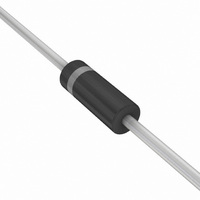1N5384BG ON Semiconductor, 1N5384BG Datasheet - Page 6

1N5384BG
Manufacturer Part Number
1N5384BG
Description
DIODE ZENER 160V 5W AXIAL
Manufacturer
ON Semiconductor
Series
Surmetic™r
Datasheet
1.1N5349BRLG.pdf
(7 pages)
Specifications of 1N5384BG
Voltage - Zener (nom) (vz)
160V
Voltage - Forward (vf) (max) @ If
1.2V @ 1A
Current - Reverse Leakage @ Vr
500nA @ 122V
Tolerance
±5%
Power - Max
5W
Impedance (max) (zzt)
350 Ohm
Mounting Type
Through Hole
Package / Case
Axial
Operating Temperature
-65°C ~ 200°C
Zener Voltage
160 V
Voltage Tolerance
5 %
Zener Current
29.4 mA
Power Dissipation
5 W
Maximum Reverse Leakage Current
0.5 uA
Maximum Zener Impedance
350 Ohms
Maximum Operating Temperature
+ 200 C
Mounting Style
SMD/SMT
Minimum Operating Temperature
- 65 C
Voltage Regulation Accuracy
3 V
Zener Voltage Vz Typ
160V
Power Dissipation Pd
5W
Operating Temperature Range
-65°C To +200°C
Diode Case Style
017AA
Diode Type
Zener
Filter Terminals
Axial Leaded
Leaded Process Compatible
Yes
Rohs Compliant
Yes
Lead Free Status / RoHS Status
Lead free / RoHS Compliant
Other names
1N5384BG
1N5384BGOS
1N5384BGOS
Available stocks
Company
Part Number
Manufacturer
Quantity
Price
Company:
Part Number:
1N5384BG
Manufacturer:
ON Semiconductor
Quantity:
1 873
Company:
Part Number:
1N5384BG
Manufacturer:
ON
Quantity:
30 000
diode is temperature dependent, it is necessary to determine
junction temperature under any set of operating conditions
in order to calculate its value. The following procedure is
recommended:
q
power dissipation.
DT
temperature and may be found from Figure 4 for a train of
power pulses or from Figure 1 for dc power.
LA
Since the actual voltage available from a given Zener
Lead Temperature, T
Junction Temperature, T
JL
is the lead‐to‐ambient thermal resistance and P
is the increase in junction temperature above the lead
T
T
L
DT
L
J
= q
, should be determined from:
= T
JL
J
LA
, may be found from:
= q
L
P
+ DT
JL
D
+ T
100
P
0.1
10
JL
D
1
80
A
Figure 9. Zener Voltage versus Zener Current
100
APPLICATION NOTE
120
D
1N5333B Series
http://onsemi.com
V
is the
Z
V
= 82 thru 200 Volts
Z
, ZENER VOLTAGE (VOLTS)
140
6
of P
Changes in voltage, V
q
from Figures 2 and 3.
vary with time and may also be affected significantly by the
zener resistance. For best regulation, keep current
excursions as low as possible.
capability. Surge limitations are given in Figure 5. They are
lower than would be expected by considering only junction
temperature, as current crowding effects cause temperatures
to be extremely high in small spots resulting in device
degradation should the limits of Figure 5 be exceeded.
160
VZ
For worst‐case design, using expected limits of I
Under high power‐pulse operation, the Zener voltage will
Data of Figure 4 should not be used to compute surge
, the Zener voltage temperature coefficient, is found
D
and the extremes of T
180
200
Z
DV = q
, can then be found from:
220
VZ
J
DT
(DT
J
J
) may be estimated.
Z
, limits







